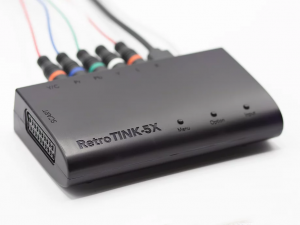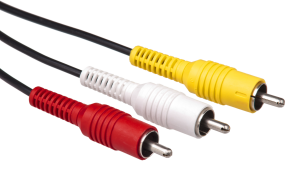AV:RetroTINK-5X Pro
RetroTink 5X Pro
The RetroTink 5X Pro is an advanced video upscaler designed by Mike Chi. It is the latest offering from the RetroTink line of graphics upscalers and line-doublers.
How To Use The RetroTink5x Pro - A Beginner’s Guide
The Retrotink 5x Pro is a product designed to solve the problem of using retro video game consoles with modern flat panel displays. If you’ve arrived at this guide, you’re probably aware of some problems when trying to play older video game systems on a newer TV:
HDMI vs Analog
In many situations, the cables that came with your game system will not be compatible with the modern digital HDMI inputs on your TV. One of the main features of the RetroTink 5X Pro (abbreviated as the “Tink 5x”) is to convert these signals into an HDMI format your modern display can understand.
Correct Image Processing
In the cases that your display does have the correct hook ups to connect your console, there’s still a good chance that the resulting output will be blurry, distorted and laggy. This is because most displays are designed with video content in mind, and the video processing used to handle video isn’t a good fit for retro consoles. Features like minimal and consistent latency, integer scaling and proper handling of 240p are almost always missing when using a flat panel’s included analog inputs.
Lag
lag (aka latency) is the measurement of the time between a controller button input to when the action is shown on screen. Every electronic device takes a little bit of time to do its job. In the context of gaming, this includes the controller itself, the video game console, any upscalers or splitters in the signal chain, and the display. Having too much lag in a setup can make gameplay feel sluggish, unresponsive, and in extreme cases unplayable. This is why enthusiasts seek devices (controllers, displays, upscalers, etc.) that minimize latency. Devices that do their job as quickly as possible are often referred to as "low lag" or "virtually no lag". The Tink 5X by design is an extremely low lag device, and includes advanced modes to operate even more quickly (with trade offs to other features, see Triple Buffer vs Frame Lock Mode and ).
Just Play the Damn Game™
Thanks to Mike Chi’s research and engineering, the Tink 5x is one of the best products on the market specifically built to address the peculiarities of retro video game analog signals. While a complex engine of tweakability lies under the hood for enthusiasts, the Tink 5x prioritizes ease of use so anyone can get their console up in running.
Here are the basic steps anyone can take to get a great experience with their retro video game console:
- Connect the Tink 5x to your display using an HDMI cable.
- Connect your video game console’s video and audio to the Tink 5x using a supported cable (link to supported inputs section).
- Power on the Tink 5x using the included MicroUSB cable - many TV’s will have a USB hookup on the back that will work as a power source.
- Using the included remote, select the appropriate input from the Input Source menu. (This choice depends on the cable you are using to connect your video game console to the Tink 5x, see “Supported Inputs” section for more information).
- Using the included remote, select the appropriate output from the Output Res. menu. (For most TV’s, 1080p (Fill) is a great “all around” choice.)
And that’s it! You don’t have to be an A/V engineer to get remarkable results from the Tink 5x, all the hard work is done behind the scenes. Understanding jargon such as automatic phase detection, polyphase scaling or motion adaptive deinterlacing isn’t required for you to gain the benefits and enjoy your retro consoles on a flat panel with great results.
Supported Inputs
The Tink 5x supports nearly every major analog video format used by retro video game consoles. Here is a list of the supported signals and some common systems that used them.
Composite
This is the “standard yellow video cable” most people are familiar with. Composite video cables were found on consoles ranging from the NES all the way through the Xbox 360 / PS3 era of gaming.
To use composite video: plug your cable’s video RCA plug (typically yellow in color) into the Tink 5x’s “Y” labeled input, and your left and right audio into the “L” and “R” inputs respectively. Then, select Composite from the Tink 5x’s Input Source menu.
SCART-CV
The Tink 5x supports composite input over the SCART connector input. SCART was not widely used in the United States but was common in Europe, and video game consoles sometimes featured composite video and audio connections over SCART.
To use SCART-CV, plug in an appropriately wired SCART cable or use RCA cables for video/audio with a compatible SCART breakout adapter, and select SCART-CV from the Tink 5x’s Input Source menu.
S-Video
S-Video is an iteration of composite video that features two parts of the composite signal (Y and C) across two separate wires. Using S-Video cables are typically regarded as a visual improvement over “standard” composite cables. Consoles that supported S-Video output include (but not limited to) PlayStation, Nintendo 64, Saturn and Dreamcast.
To use S-Video with the Tink 5x, plug the S-Video cable into the Tink 5x’s “Y/C” input, and your left and right audio into the “L” and “R” inputs respectively. Then, select S-Video from the Tink 5x’s Input Source menu.
YPbPr / Component
SCART-RGB
Advanced Features
Triple Buffer vs Frame Lock Mode
Console Specific Horizontal Sampling Modes
The Tink 5X includes "Optimal Timings" to get the sharpest output from your console. Here are the included presets:
H. Sampling Presets:
Generic 4:3
Generic 16:9
SNES/PCE 256
Gen/Sat 320
PS1 320
N64 320
NEOGEO 320
Saturn 352
PS1 384
HiRes 512
HiRes 858
Post Processing Filters
Presets:
Slot Mask
A. Grille -1
BVM
PVM-600
FV310
Consumer-1
Consumer-2
LCD
Saving and Loading Profiles
Console Specific Recommendations
Wobbling Pixel's Recommended Settings
Link to Wobbling Pixel's YouTube Channel
"VGA" Over "RGB" with Sync Combiners
Firmware Updates and Version Differences
RetroTink 5x Pro GUI Map
RetroTINK-5X Pro Main Menu
[Input]
Opens the Input Source Menu.
[Output Res.]
Opens the Output Resolution Menu.
[Scaling/Crop]
Opens the Scaling/Cropping Menu.
[Interp./Deint.]
Opens the Interpolation/De-interlacing Menu.
[H. Sampling]
Opens the Horizontal Sampling Menu.
[Post. Proc.]
Opens the Post-Processing Menu.
[SDTV Decoder]
Opens the Standard Definition Decoder Menu.
[Video ADC]
Opens the Video ADC Menu.
[HDMI]
Opens the HDMI Output Menu.
[OSD]
Opens the On-Screen Display Menu.
[Save Profile]
Opens the Save Profile Menu.
[Load Profile]
Opens the Load Profile Menu.
[Status]
Opens the Status Menu.
[About]
Opens the About Menu.
Input Source
YPbPr
Selects YPbPr input for “component” input. Supports 240p-1080i video sources.
SCART-RGB
Selects SCART-RGB input. Supports 240p/480i RGB inputs, as well as “VGA”/”858” inputs using supported sync-combining cables and hardware (see HD15-2-SCART for more info).
Composite
Selects composite input. Supports standard definition 240p / 480i video sources.
S-Video
Selects S-Video input. Supports standard definition 240p / 480i video sources.
SCART-CV
Selects composite video via the SCART connector. Composite over SCART cable or compatible RCA to SCART adapter is required. Supports standard definition 240p / 480i video sources.
YPbPr (SDP)
Selects YPbPr input using the standard definition processor (SDP). Not as sharp as the normal YPbPr input but supports better error tolerance and color adjustments. Only accepts standard definition 240p or 480i sources.
Output Resolution
1080p (Fill)
Selects 1080p (Fill) output mode. In this mode, the video source will be stretched vertically to fit the screen. Pro’s: None of the video information is cropped, all of the vertical screen space is used. Con’s: Somewhat softer image due to the non-integer scaling.
1080p (Over)
Selects 1080p (Over) output mode. In this mode, a 240p signal will be multiplied 5 times and 480i / 480p are multiplied 2.5 (2.5x) times. The output will slightly exceed the vertical edges of the 1080p frame and be cropped at the top and bottom. Many retro games accommodate this cropping as they were intended to be played on CRT’s that typically cropped this area as well. Pro’s: Larger playfied due to the 5x scale and sharp image thanks to integer scaling. Con’s: Vertically cropped image.
1080p (Under)
Selects 1080p (Under) output mode. In this mode, a 240p signal will be multiplied 4 times and 480i / 480p are multiplied 2 times. The video output will be centered on the screen with a black border. Pro’s: Sharp integer scaled output. Con’s: Smaller image / unused 1080p screen space.
1080p (Min-Lag)
Selects 1080p (Min-Lag) output mode. In this mode, 240p, 480i and 480p sources are scaled in approximately 1 millisecond to achieve the absolute lowest possible latency.
1200p
Selects 1200p output mode.
720p
Selects 720p output mode.
480p
Selects 480p output mode.
Output Resolution (Advanced Res)
The following outputs are disabled by default and can be enabled by setting “Advanced Res” to “On” in the [OSD] (On-Screen Display) menu.
1920x1440p
Selects 1920x1440p output mode.
2560x1440p
Selects 2560x1440p output mode.
4K (24/25Hz)
Selects 4K (24/25Hz) output mode.
1536p (iPad)
Selects 1536p (iPad) output mode.
Scaling/Cropping
H Position
Adjusts the horizontal position of the image. Ranges from “-508” to “+512” values and steps in increments of “4”. Default value is “+0”.
V Position
Adjusts the vertical position of the image. Ranges from “-128” to “++127” values and steps in increments of “1”. Default value is “+0”.
H (Interp) Size
V Size
H Crop Start
H Crop End
V Crop Start
V Crop End
Interpolation/De-interlacing
Vertical Filter
Deinterlacer
Bob Offset
Bob Scanline
Field Order
Pre-scaler
Horizontal Sampling
Preset
Phase Detect
Lock Speed
ADC Samp./Line
H (Interp) Size
Allow Interlace
Post-Processing
Load Preset
+Scanline Beam
+Scanline Str.
+Intensity Mod.
+Mask
+Gamma Boost
+Color Boost
+Pre-emph
Standard Definition Decoder
Brightness
Chroma
Phase
Contrast
Y/C Filter
Aperture
CTIE
Black Level
Video ADC
SDTV LPF
EDTV LPF
SoG Thresh
LLPLL Gain
LLPLL BW
Pre-Coast
Post-Coast
ADC Phase
HDMI Output
V-Sync
Lock to 60 Hz
Colorspace
Chroma Mode
Blue Only
Disable CSC
AVINFO AR
TMDS Clock:
On-Screen Display
Size
Blanking Color
Lightgun Border
Startup Profile
Advanced Res
Save Profile
Slot 1 - Slot 10
Load Profile
Slot 1 - Slot 10
Default
Status
Source:
Output Res:
No Signal (or if a signal is detected:)
Input Lines:
Input H-Freq:
Input V-Freq:
Samples/Line:
ADC Clock:
Ticks/Frame:
[About]:
RETROTINK-5X Pro © 2021-2-22 RetroTINK LLC All Rights Reserved (QR CODE) Need Help? Scan the QR Code to Join the RetroTINK Discord
TO DO
Notes / Ideas Feature matrix from version to version output resolutions, sampling modes, +/- ranges for stuff like pre-emph

